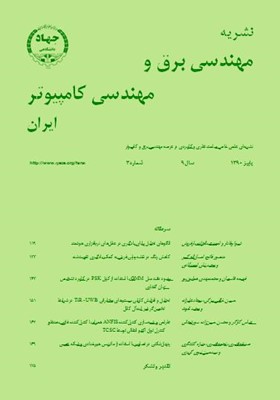کاهش رنگ در نقشه چاپی فرش به کمک یادگیری تقویتشده
محورهای موضوعی : مهندسی برق و کامپیوتر
منصور فاتح
1
,
احساناله کبیر
2
![]() ,
مجید نیلی احمدآبادی
3
,
مجید نیلی احمدآبادی
3
1 - دانشگاه تربیت مدرس
2 - دانشگاه تربیت مدرس
3 - دانشگاه تهران
کلید واژه: یادگیری تقویتشده پالت رنگ کاهش رنگ نقشه فرش,
چکیده مقاله :
خواندن خودکار نقشههای فرش به معنی تعیین نقشه با تعداد رنگ مشخص از روی نقشه اسکنشده است. خواندن خودکار شامل دو مرحله تشخیص خطوط نقشه و کاهش تعداد رنگ پیکسلهای تصویر است. کاهش رنگ نیز از دو مرحله طراحی پالت و نگاشت رنگ پیکسلهای تصویر به رنگهای پالت تشکیل میشود. برای کاهش رنگ، روشهای متنوعی وجود دارد که دقت آنها از اهمیت بالایی برخوردار است و حتی در برخی از روشها برای افزایش دقت برای طراحی پالت از کاربر کمک گرفته میشود. هدف از این تحقیق ارائه روش کاهش رنگ کاملاً خودکار با دقت بالا است. برای این منظور از روش یادگیری تقویتشده استفاده شده است که دقتی بالغ بر 98% دارد. تاکنون از این روش برای کاهش رنگ استفاده نشده است. روش پیشنهادی با توجه به کاربرد، تعریف شده است و میزان کاهش رنگ بهنحوی است که دقت الگوریتم کاهش پیدا نکند. از این رو پالت نهایی، از تعداد رنگ بیشتری در مقایسه با پالت اصلی برخوردار است. در کار ارائهشده در این مقاله، ابتدا خطوط نقشه آشکار میشوند و رنگ پیکسلهای درون هر خانه نقشه به یک پیکسل نگاشت میشود و سپس با استفاده از روش یادگیری تقویتشده کاهش رنگ انجام میشود. نتایج حاصل از آزمایش روش پیشنهادی بر روی چند تصویر نمونه ارائه و بررسی میشود.
Automatic reading of carpet patterns Requires To find the original colors of the pattern in a scanned image. It includes detecting of pattern lines and reducing the number of colors in the image. Color reduction is done in two steps: Finding the best pallet and mapping the image colors to the pallet colors. The accuracy of color reduction is so important that it may be required to ask for user intervention. The purpose of this study is to provide a new method in automatic color reduction with high accuracy. To achieve this target, reinforcement learning method is used which yields a 98% accuracy. This is a new method in color reduction and no one has used it yet. This method is defined with respect to the application and the amount of color reduction is such that does not degrade the accuracy. Therefore, the resulting pallet has more colors comparing to the original one. In the work reported in this article, first the grid lines of the pattern are detected. Then a single color is assigned to each box of the grid. After these steps, through the reinforcement learning method the color reduction is carried out. The results obtained from applying the proposed algorithm on some sample images are reported and discussed.
[1] A. Atsalakis and N. Papamarkos, "Color reduction and estimation of the number of dominant colors by using a self - growing and self - organized neural gas," Engineering Applications of Artificial Intelligence, vol. 19, no. 7, pp. 769-786, May 2006.
[2] N. Papamarkos, A. E. Atsalakis, and C. P. Strouthopoulos, "Adaptive color reduction," IEEE Trans. on Systems, vol. 33, no. 1, pp. 44-56, Feb. 2002.
[3] A. H. Dekker, "Kohonen neural networks for optimal color quantization," Network: Computat. Neural Syst., vol. 5, no. 3 pp. 351-367, 1994.
[4] Z. Xiang, Handbook of Approximation Algorithms and Metaheuristics, Chapman & Hall/CRC, Ch. Color Quantization, pp. 86/1–86/17, 2007.
[5] A. Mojsilovic and E. Soljanin, "Color quantization and processing by fibonacci lattices," IEEE Trans. on Image Processing, vol. 10, no. 11, pp. 1712-1725, Nov. 2001.
[6] M. E. Celebi, "Improving the performance of K - means for color quantization," Image and Vision Computing, vol. 29, no. 4, pp. 260-271, Jan 2011.
[7] J. P. Braquelaire and L. Brun, "Comparison and optimization of methods of color image quantization," IEEE Trans. on Image Processing, vol. 6, no. 7, pp. 1048-1052, Jul. 1997.
[8] P. Scheunders, "A comparison of clustering algorithms applied to color image quantization," Pattern Recogn. Lett., vol. 18, no. 11-13, pp. 1379-1384, Jul. 1997.
[9] D. M. Tsai, "A fast thresholding selection procedure for multimodal and unimodal histograms," Pattern Recognit. Lett., vol. 16, no. 6, pp. 653-666, Jun. 1995.
[10] A. T. Ghanbarian, E. Kabir, and N. M. Charkari, "Color reduction based on ant colony," Pattern Recognition Letters, vol. 28, pp. 1383-1390, Sep. 2007.
[11] Z. Bing, S. Junyi, and P. Qinke, "An adjustable algorithm for color quantization," Pattern Recognition Letters, vol. 25, no. 16, pp. 1787-1797, Dec. 2004.
[12] ا. ايزدیپور و ا. کبير، "ارائه روشی برای خواندن خودکار نقشه چاپی فرش و مقایسه آن با روش خوشهیابی میانگین - C،" نشریه مهندسی برق و مهندسی کامپیوتر ایران، جلد 8، شماره 1، صص. 56-48، بهار 1389.
[13] شرکت سهامی فرش ايران، (www.irancarpet.ir).
[14] ا. ايزدیپور و ا. کبير، "شناسايی خودکار خطوط نقشه فرش،" اولين کنگره مشترک سيستمهای فازی و هوشمند، مشهد، شهريور 1386.
[15] شرکت بوريا (www.booria.com/carpetdesigner.htm).
[16] مرکز کنترل کامپيوتر ايران، نرمافزار نقشساز (www.centraltouch.com).
[17] R. S. Sutton and A. C. Barto, "Reinforcement learning an introduction," Jan. 2005.
[18] Y. Zheng, H. Li, and D. Doermann, "A model - based line detection algorithm in documents," in Proc. of the 7th Int. Conf. on Document Analysis and Recognition, ICDAR,vol. 1, pp. 44-48, Aug. 2003.
[19] J. Sun, F. Zhou, and J. Zhou, "A new fast line detection algorithm," Proc. Fist Int. Symp. Systems and Control in Aerospace and Astronautics, pp. 831-833, Jan. 2006.
[20] http://www.colorpilot.com/layer.html


